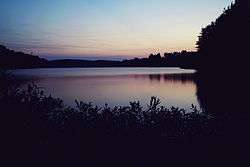Lake Conway
| Lake Conway | |
|---|---|
 | |
| Location |
Faulkner County, Arkansas, United States |
| Coordinates | 35°00′19″N 92°23′32″W / 35.0053°N 92.3921°WCoordinates: 35°00′19″N 92°23′32″W / 35.0053°N 92.3921°W |
| Type | reservoir |
| Primary inflows | Stone Dam Creek, Palarm Creek, Panther Creek, Little Cypress Creek, Gold Creek |
| Basin countries | United States |
| Max. length | 8 mi (13 km) |
| Surface area | 6,700 acres (27 km2) |
| Average depth | 6 ft (2 m) |
| Max. depth | 18 ft (5 m) |
Lake Conway, a 6,700-acre (27 km2) lake in Arkansas, is the largest reservoir made by a game and fish commission in the United States. It is located just a few miles southeast of Conway, Arkansas.
Overview
Construction on Lake Conway began in 1948, with water fed by Stone Dam Creek, Palarm Creek, Panther Creek, Little Cypress Creek and Gold Creek. Lake Conway is on average 6 feet (2 m) deep, and is 18 feet (5 m) at the deepest.
Lake Conway Dam is an earthen structure still owned by the Arkansas Fish and Game Commission, 16 feet high and impounding a maximum capacity of 40,200 acre-feet.[1] The lake is approximately 8 miles (13 km) in length, and has approximately 52 miles (84 km) of shoreline. Lake Conway is a popular fishing destination. The lake is full of bass, catfish, bream and crappie. The Arkansas Game and Fish Commission maintains many free public areas on the lake, and boat rentals can be found on many commercial docks. The official name of the lake was changed in June 2011 to Craig D. Campbell Lake Conway Reservoir.
Mythology
Rumors abound regarding a large "skunk ape" or "Fouke Monster" like creature that inhabits the shallow waters, various islands and numerous inlets around Lake Conway. The Lake Conway Monster hysteria peaked in the 1970s and has declined since then. While no photographs are known to exist of the Lake Conway Monster, reports of large creatures in the lake and strange goings-ons are still reported to this day.
Environmental Concerns
On March 29, 2013 5,000 barrels of crude oil spilled from the Exxon Pegasus pipeline in Mayflower, Arkansas, putting the lake and wildlife at risk.[2]
See also
References
- ↑ "Lake Conway, central Arkansas". Retrieved 2012-08-31.
- ↑ "Exxon cleans up Arkansas oil spill; Keystone plan assailed". Reuters. Retrieved 1 April 2013.